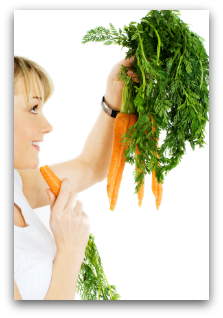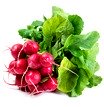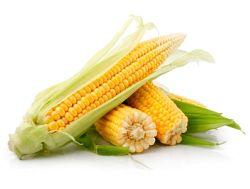Healthy Vegetarian Diets —
Getting One of Those for Yourself
Healthy vegetarian diets—are
those just a happy fantasy or actually do-able in the real world? Both,
actually, at least in my own experience. So let's talk about some ways
you can develop such a diet for yourself...if that's what you genuinely want.

Your first step: developing a few "vegetarian-friendly" habits, such as planning and prepping ahead (see below). Please get into the habit of this, as you're going to need easy (and quick) access to fruits and veggies to maintain a healthful vegetarian diet.
Plus, you’ll also need plenty of appropriate
protein on hand: tofu, seitan, eggs and dairy (if you're not
vegan), legumes and grains, nuts... (See vegetarian protein sources.)
Keep Veggies Handy!
Often, healthy vegetarian diets rise or fall according to how well people manage their fruits and veggies.
Even with many such goodies right there at home, you may still
consume too few if they’re not clean and ready to eat. After a long day,
who wants to wash and cut up a bunch of veggies, right? Isn't it a lot
easier at that point just to reach for the fatty snacks and forget about the healthier stuff?
So, maybe that's what you do, but it's costing you. It costs you the healthier diet you may be going for. It costs you the pride you'd otherwise feel in yourself for prevailing against the Snack Trolls. It costs you the money you may eventually throw away with the fruits and vegetables that have eventually spoiled while awaiting your attention. Bummer.
Try This Instead

When you bring vegetables home
from the store or farmers market, don’t just thrust them into the
refrigerator to await another day. Wash those veggies instead, and then refrigerate in
air-tight containers. If you live in an area where veggies are available
already washed and
bagged, you might bring some of those home now and then. If you tend to procrastinate with the produce prep (as do a lot of us), those products could save you time and possibly even a little money.
If you're tempted by sauces and dips for those veggies and by seeds and nuts in general, do pay attention to how often you indulge and how much. Otherwise, your bathroom scales could give you a nasty surprise.
Remember, too, that “vegetarian” pizza and pastas can be loaded with
calories, carbs, and fat. So if weight is an issue for you, consider eating those only as an occasional treat or
preparing your own low-fat/cal versions. (What a grouch, huh?)
Healthy Vegetarian Diets Need Protein
As a practicing or would-be vegetarian, you'll need to stay more aware of
your protein intake than you might do as a “flexitarian” or carnivore...at least, in the beginning. Although you’ll have plenty of protein choices, they won’t always be as readily available. So here, too, pre-prepping really pays off.
For example, cook a generous supply of legumes
to freeze in small quantities; you can then quickly thaw these for meals
and snacks. Do the same with tofu and seitan. And try to keep
commercial meat substitutes on hand, as well—although check these for
excess sodium and fat. You can also put together packets of your own
trail mix, with seeds, nuts, a little dried fruit/veggies, and
dehydrated seitan. (Click for tips on dehydrating seitan.)
Bottom line? If it's what you genuinely want, you can
"do" vegetarian just fine if you simply plan ahead. That's how I manage it
myself, and you can probably do so as well. Why not go for it, if it feels right for you?
You can always dial back if it's not working out. But if you never start, you'll never know.
Please understand that the material at this site is NOT medical advice, as I am neither doctor nor nutritionist. What I am is merely someone who's lived successfully on a vegetarian diet for many decades...and I transitioned from omnivore to vegetarian gradually. Do check with your doctor, though, if you're considering big changes to your own diet. Also, be sure to find a dependable source of Vitamin B12.
Living Vegetarian the Easy Way
Copyright 2010-2024. Lynda Edwards. All rights reserved.



